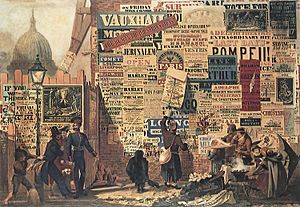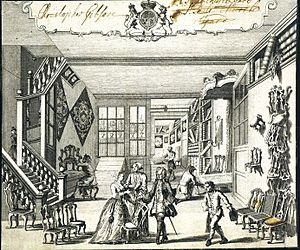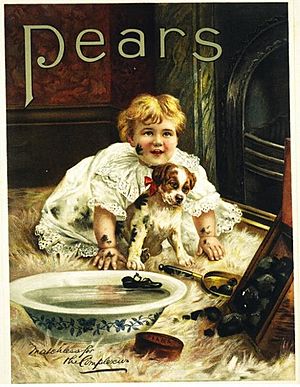History of advertising in Britain facts for kids
Advertising in Britain has a long history. It has been a big part of the country's economy for about 300 years. Advertising agencies started in the mid-1800s. They mainly used newspapers and magazines. In the 1900s, advertising grew fast with new tools. These included direct mail, radio, and television. London is still a very important place for advertising around the world. Recently, the internet and smartphones have changed advertising a lot. To learn more about advertising today, see Advertising.
Early Days of British Advertising
Advertising in the 1700s
In the 1700s, there were three main ways to advertise. These were trade cards, posters on buildings, and small newspaper ads.
Trade cards were very popular. They were small printed cards with pictures. Shops and traders gave them to customers. The cards described one product. The hope was that customers would share them with friends and family.
In Scotland, writers for newspapers in the mid-1700s learned something new. They realized ads were not just for facts about the seller. Ads could make people imagine things. They could also make products seem more valuable. These ads aimed at richer readers. They used special language to build trust. This trust linked the maker, the product, and the buyer. One common idea was to celebrate Scottish pride. Another idea was to show that a product had royal approval. Or they would share notes from doctors and important local people.
Newspaper ads started to appear in England in the 1700s. These early ads mostly promoted books and newspapers. Books became cheaper as printing improved. Ads also promoted medicines. People wanted medicines more as diseases spread across Europe. In 18th-century Britain, newspaper ads were also used to find people. They described people who had left without permission. These included servants, apprentices, soldiers, and even spouses.
Advertising in the 1800s
In the late 1700s, women became a target for ads. Magazines and newspapers started showing beauty products. These products were sold all over the country. Ads used brand names and aimed at certain groups of people. Richer women were encouraged to buy more expensive clothes and makeup. Ads would say things like Pears's Liquid Bloom of Roses made cheeks and lips beautiful. It would give a delicate look.
Men, however, got a different kind of ad. An ad for John Gowland's spot cream in 1791 gave a strong warning:
- This cream helps with all skin problems. It works for small pimples or widespread rashes. It helps with red noses or other body parts. It is good for every skin issue, whether red and inflamed, or dull and stubborn.
In the early 1800s, Nahum Ward, a businessman from Edinburgh, bought land in America. He then sold this land to farmers in Scotland. He advertised a lot in magazines and with posters. These ads talked about how good and cheap the new land was. Throughout the 1800s and early 1900s, American, Canadian, Australian, and New Zealand railroads also advertised in Britain. They sold land and travel.
In London in the late 1800s, Thomas J. Barratt was called "the father of modern advertising." He worked for the Pears Soap company. Barratt made a very good advertising plan for Pears products. He used special slogans, pictures, and phrases. His ad budget reached £80,000 a year. One of his famous slogans was, "Good morning. Have you used Pears' soap?" People knew this slogan well even into the 1900s.
Barratt linked the Pears brand to high culture and quality. A famous example was using the painting Bubbles by John Everett Millais. He added a bar of Pears soap to the picture for an ad. Millais did not like this change, but Barratt owned the copyright. Barratt continued this idea with ads showing well-dressed middle-class children. This linked Pears to comfort at home and modern cleanliness.
Barratt started Pears Annual in 1891. It was a magazine that showed new art and color printing. In 1897, he added the Pears Cyclopedia, a one-volume encyclopedia. From the early 1900s, Pears was known for its "Miss Pears" contest. Parents would enter their children to become a young face for the brand. This child would appear on product packaging and in ads. He also got scientists and famous people to say good things about the product. Lillie Langtry, a British singer and actress, was known for her pale skin. She was the first woman to be paid to advertise a product, Pears Soap.
Barratt created many key ideas for good advertising. These ideas were shared widely in his time. He always said it was important to have a strong and special brand image for Pears. He also stressed making sure the product was everywhere. He knew it was important to keep checking what people liked. In 1907, he said, "Tastes change, fashions change, and the advertiser has to change with them. An idea that worked a generation ago would not work today. It's not that today's idea is always better, but it is different – it fits today's taste."
Advertising in the 1900s
Environmental Awareness in Advertising
After 1970, caring for the environment became a common theme in ads. But Shell Oil was one of the first to do this in the 1930s. Their ads rarely showed Shell's petrol or oil. They also did not show drilling rigs or oil tankers. Instead, their artists drew peaceful country scenes, small towns, and old buildings.
"Greenwashing" is when a company spends more money on making itself look eco-friendly than on actually being eco-friendly. It is a trick in advertising. It tries to fool buyers who want to buy from environmentally friendly brands.
Advertising During World War II
Thomas Lipton (1848-1931) advertised a lot for his grocery stores and his Lipton teas. He said his secret to success was selling the best goods at the lowest prices. He also used the power of advertising and was always hopeful.
During the Second World War, millions of American soldiers came through Britain. People worried that British businesses and culture would become too "American." The Marshall Plan even asked for British industry to improve its marketing skills. London advertising leaders worried about what the rich Americans would do. Radio and television could not have ads. This was because the BBC got money from fees paid by radio owners. People wondered if the well-funded American ways would be too strong to resist. JWT London was an American-owned ad agency. It was controlled by J. Walter Thompson in New York City. JWT London did not push the American style. Instead, it used gentle persuasion. It became less American to fit the quiet British style.
Tobacco Advertising and Health Concerns
By the 1950s, people worried that smoking tobacco caused cancer. This made the tobacco industry nervous. They asked advertisers for help to stop people from buying less and to avoid more rules. British and American agencies found similar answers. The Tobacco Manufacturers' Standing Committee in Britain calmed public fears. They made people think cigarette makers were solving problems with filters and low-tar cigarettes. This public relations approach worked for a short time. But more and more medical proof led to less smoking. It also led to higher taxes and more rules. Ad agencies then created smart ways to encourage young people to smoke. They also tried to find new smokers in other countries. Governments started anti-smoking programs. These programs used regular advertising methods. They tried to make smoking seem less cool and warned about its dangers.
American Advertising Agencies in Britain
New York ad agencies opened offices in London. They mainly wanted to work with American companies that had offices all over the world, like General Motors. These American agencies had much more money. They grew fast from 1945 until the late 1970s. By then, they were the biggest in the British advertising market.
However, British firms fought back in the early 1980s. They had more access to money. British companies grew by buying American agencies. They did not just serve British companies that worked worldwide. In terms of art, the 1960s were a key time. American ideas changed British agencies. Britons were already trying new things in music, fashion, and design. So, they quickly took on the American advertising styles. The first D&AD (Design and Art Direction) awards started in 1963. They helped set high standards for advertising. The trade magazine Campaign began in 1968. Alfredo Marcantonio said, "What happened in New York led to what is now seen as the golden age of British advertising."
More About Advertising
- Advertising campaign
- Advertising Standards Authority (United Kingdom)
- Campaign (magazine), Based in London
- D&AD, Design and Art Direction awards
- History of advertising, Global coverage
- History of Advertising Trust
- London International Awards
- Museum of Brands, Packaging and Advertising
Advertising Agencies
- Bartle Bogle Hegarty
- Crawford's Advertising Agency
- DDB Worldwide
- FCB (advertising agency)
- HHCL
- J. Walter Thompson
- Mullen Lowe Group
- Ogilvy & Mather
- WPP plc





